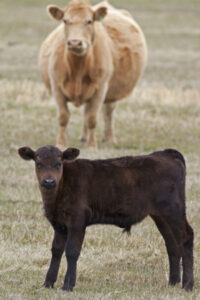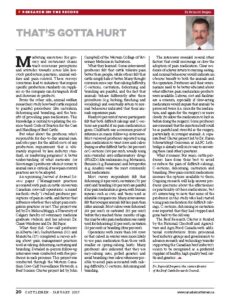That’s Gotta Hurt
This article written by Dr. Reynold Bergen, BCRC Science Director, originally appeared in the January 2017 issue of Canadian Cattlemen magazine and is reprinted on the BCRC Blog with permission of the publisher.

Marketing executives for grocery and restaurant chains track consumer perceptions and attitudes towards issues like livestock production practices, animal welfare and pain control. These surveys sometimes lead to initiatives that impose specific production standards on suppliers so the company can distinguish itself and showcase its products.
From the other side, animal welfare researchers study how beef cattle respond to painful procedures like castration, dehorning and branding, and the benefit of providing pain medication. This knowledge is central to updating the science-based Code of Practice for the Care and Handling of Beef Cattle.
But what about the producer, who’s responsible for day to day animal care, and who pays for the added costs of any production requirement that is ultimately imposed by law, industry standard, or marketing programs? A better understanding of what motivates (or discourages) producers when it comes to animal care is critical, if new pain control practices are to be adopted.
An upcoming Journal of Animal Science paper (“Management practices associated with pain in cattle on western Canadian cow-calf operations: a mixed methods study”) studied producer perceptions of pain in cattle, and factors that influence whether they adopt pain mitigation practices or not. This project was led by Dr. Melissa Moggy, a University of Calgary Faculty of Veterinary Medicine graduate student, and her advisors Dr. Claire Windeyer and Dr. Ed Pajor.
What they did
Cow-calf producers in Alberta (46), Saskatchewan (31) and Manitoba (17) completed a survey asking about pain management practices used at calving, dehorning, castrating and branding. Detailed in-person follow-up interviews were conducted with five producers in each province. This project was conducted through the Western Canadian Cow-Calf Surveillance Network, a Beef Science Cluster project led by John Campbell of the Western College of Veterinary Medicine in Saskatoon.
What they learned
Some interviewed producers felt that cattle tolerate pain better than people, while others felt that cattle simply hide it better. Many thought common sense says that calving difficulty, C-sections, castration, dehorning and branding are painful, and the fact that animals behave differently after these procedures (e.g. kicking, flinching, and vocalizing) and eventually return to normal behavior indicated that their animals experience pain.
Nearly 90% of survey participants felt that both difficult calvings and C-sections are painful if no pain medication is given. Child birth was a common point of reference in many follow-up interviews. Most surveyed producers reported using pain medication to treat cows and calves during or after difficult births (46%) or C sections (100%), usually using non-steroidal anti-inflammatory drugs (NSAIDs) like meloxicam (e.g. Metacam), flunixin (e.g. Banamine) and ketoprofen (e.g. Anafen) were the most commonly used medications.
Most survey respondents felt that dehorning (84%), castration (72%) and branding (85%) are painful if no pain medication is given, with human injuries such as cuts, and burns used as relatable comparisons. Many interviewees felt that younger animals felt less pain than older animals. Most calves were dehorned (89%) or castrated (95%) before they reached 3 months of age; this may be why pain medication was rarely used for dehorning (15%), castration (10%) or branding (4%).
Operations with more than 300 cows or that calved in winter were more likely to use pain medication than those with smaller or spring-calving herds. Many producers also indicated that they use easy-calving sires, polled genetics and avoid branding steer calves whenever possible to avoid pain associated with calving difficulty, C-sections, dehorning and branding.
The interviews revealed several other factors that could encourage or slow the adoption of pain medication. Clear evidence of a faster return to nursing, eating, and normal behavior would indicate an obvious benefit to both the animals and the operation. Producers and their veterinarians need to be better educated about what effective pain medication products were available. Labor, cost and facilities are a concern, especially if slow-acting medications would require that animals be processed twice (i.e. once for the medication, and again for the surgery) or more slowly (to allow the medication to kick in before doing the surgery). Some producers are concerned that the injection itself could be as painful and stressful as the surgery, particularly in younger animals. A separate Beef Cluster project led by Dr. Karen Schwartzkopf-Genswein at AAFC Lethbridge is already well on its way to answering these (and other) questions.
What it means
For years, cattle producers have done their best to avoid or reduce the pain of difficult calvings, C-sections, dehorning, castration and branding. New pain control medications increase the options available to them. Ongoing research will help answer producer questions about the effectiveness or practicality of these medications, but it’s interesting to note that none of the producers in this study who had started using pain medication for difficult calvings, C-sections, dehorning or castration ever reported ever stopped and gone back to the old way.
Click here to subscribe to the BCRC Blog and receive email notifications when new content is posted.
The sharing or reprinting of BCRC Blog articles is typically welcome and encouraged, however this article requires permission of the original publisher.
We welcome your questions, comments and suggestions. Contact us directly or generate public discussion by posting your thoughts below.
